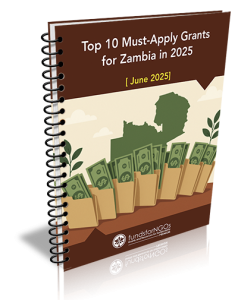Deadline: 10-May-2024
TogetHER for Health is pleased to launch the Cervical Cancer Grants Program to improve both demand and supply of cervical cancer prevention services.
TogetHER’s Cervical Cancer Grants Program provides highly targeted grants for organizations working to address demand and supply constraints related to vaccination, screening, and preventive treatment for HPV and cervical cancer. Interventions supported by this program should be catalytic, improving the lives of individuals directly served with the allocated funds and triggering health system-wide improvements (e.g., policy change, regulatory approval, development of effective tools and strategies) to support cervical cancer elimination efforts.
Tracks
- Applicants will be required to submit their applications to either of two tracks, as follows:
- Track 1: Problem Statement: Demand-Side Interventions
- Track 1 aims to improve demand-side interventions to increase uptake of all cervical cancer prevention services.
- For demand side interventions, lack of evidence-based information about the relationship between HPV and cervical cancer, and information regarding preventive measures for the disease remain barriers. Stigma related to HPV and cervical cancer can undermine public health efforts to educate and inform those at risk about effective prevention measures. Reaching those who are particularly marginalized and vulnerable to HPV and cervical cancer are a priority.
- Applicants who submit to this track will outline promising interventions and strategies to address demand constraints in one or more of these areas across the continuum of care:
- Demand for HPV Vaccination: Persistent infection with certain types of human papillomavirus (HPV) can cause cervical cancer as well as a variety of other cancers. HPV vaccines currently offer complete protection against 70%-90% of cervical cancer-causing HPV types and are recognized as safe and highly effective.2 Despite a strong track of both safety and effectiveness, HPV vaccination coverage rates continue to lag behind vaccines against other preventable diseases, particularly in LMICs. Globally only 21% of eligible girls been immunized with the first dose of HPV.
- Demand for Cervical Screening: Barriers related to cervical cancer screening often are similar across countries and cultural contexts. Common barriers include low awareness, fear of screening procedures and potential negative outcomes, privacy concerns, lack of spousal support, stigma, cost of accessing services, and fear of poor treatment by health care workers.6 There is a need for patientcentered, evidence-based social and behavioral approaches to inform and educate women on the need for preventive measures like cervical screening, particularly in settings where screening programs are opportunistic. Effective strategies to promote integrated services via maternal and child health, family planning, HIV, women’s cancers and other reproductive health services targeted to girls and women across the life course are a priority.
- Demand for Pre-Cancer Treatment: For women identified with pre-cancerous lesions, timely treatment is critical to reduce risk of further disease. As with screening, common barriers associated with the uptake of preventive treatment include fear of the procedure and/or negative outcomes, lack of privacy, perceptions of poor attitudes or mistreatment by health workers, costs of preventive treatment, or lack of support by spouse or other family members.7 Effective communication strategies are needed to emphasize the benefits of pre-cancer treatment as a critical step to disease prevention and to identify effective ways to increase treatment rates among eligible, screen-positive women to improve health outcomes. Effectively communicating both the benefits and risks related to use of improved technologies is an important aspect of provider-patient communications.
- Track 2: Problem Statement: Supply-Side Interventions
- Track 2 aims to support supply-side interventions to accelerate adoption of improved technologies in cervical cancer prevention.
- Inequalities and inequities influence access along the pathway to HPV vaccination, cervical cancer screening and treatment across LMICs. Proposals that submit to this track will outline promising interventions and strategies to address supply-side barriers across one or more of these areas:
- Availability of HPV Vaccination: There are several recent positive developments in HPV vaccine supply. First, the global supply for HPV vaccines, once a major constraint in ensuring access in LMICs, is undergoing a rapid expansion due to the entry of new suppliers in the global market from China (Innovax) and India (Cervavac), which should serve to relieve both global supply constraints and reduce vaccine costs, particularly for LMIC markets. Given mounting evidence that one dose of HPV vaccine provides comparable prevention to multidose regimens in most populations, transition to single-dose HPV vaccination regimens have the potential to greatly expand the number of children/adolescents that can be immunized without expanding vaccine supply, while also removing the significant logistical and financial cost of administering follow-up doses. Nevertheless, making a transition to single dose regimens will require careful planning and monitoring across the health system.
- Availability of Cervical Cancer Screening: Visual inspection with acetic acid or with Lugol’s iodine (VIA/VILI), while frequently used to screen for cervical lesions in low-resource settings, has low to moderate sensitivity and specificity. Significant training and supervision are required to ensure adequate quality, limiting its ability for scale-up.8 Molecular testing for HPV offers significant benefits and is superior to VIA-based screening. However, HPV testing is not yet widely available, despite its robust evidence base and inclusion within the most recent WHO guidance. 9 Many programs across LMICs lack the necessary resources, training, and amenable policies to fully support the adoption and expansion to HPV testing as a primary screening method for cervical cancer. Operational questions remain around optimal service delivery models for HPV testing and treatment. Nevertheless, selfcollection of cervical samples for HPV testing is a promising approach towards broadening screening coverage, with data showing that patient-collected samples are comparable in sensitivity to samples collected by health providers.
- Availability of Pre-Cancer Treatment: While cryotherapy has been the standard treatment approach for pre-cancerous lesions globally, it poses several operational challenges that include limited supply of high-quality gas, cost of gas transport, and challenges with machine reliability. Thermal ablation was approved by the WHO in 2019 for use in treating pre-cancerous cervical lesions and appears to avoid the challenges inherent to cryotherapy. Following this global endorsement, thermal ablation is becoming the standard of care for cervical pre-cancer across many settings. However, insights are needed to facilitate its wider use in programmatic contexts at scale and to support wider adoption of this technology across LMIC settings.
- Track 1: Problem Statement: Demand-Side Interventions
Funding Information
- The maximum budget under each track of this award is $30,000 USD. The implementation period is for a maximum of 12 months.
Potential Projects to Be Funded
- Track: Improve demand-side interventions to increase uptake of cervical cancer prevention services.
- Identification of knowledge gaps and development of innovative demand creation strategies for HPV vaccination, cervical cancer screening and/or treatment services at the community level.
- Development and evaluation of communications toolkit for underserved or hard to reach populations to improve knowledge, attitudes and behaviors for cervical cancer prevention.
- Development and assessment of an integrated communications campaign to reach underserved girls and women and/or those who are otherwise hard to reach.
- Assessment of models to engage communities in HPV vaccine awareness and education to address vaccine hesitancy.
- Track: Improve supply-side interventions to accelerate adoption of improved technologies in cervical cancer prevention.
- Demonstration projects that reveal how provider behaviors may impede or facilitate adoption of HPV vaccination, screening and/or pre-cancer treatment and ways to improve uptake.
- Identifying and testing promising approaches to incorporate training, supervision, and quality assurance activities for cervical cancer prevention services.
- Strategic advocacy and policy activities to incorporate HPV vaccination into national vaccination schedules, and/or transition of HPV vaccination schedules to a single dose approach.
- Evaluation of community-based approaches to incorporate HPV testing and use of self-sampling to reach more women for screening.
Geography
- The Program limits funding to countries classified as low or middle-income countries, based on the current World Bank classification. Programs undertaken in high-income countries are not eligible to apply. Applicants should justify their selected geography based on:
- Epidemiological data demonstrating the burden of cervical cancer and/or the ability to reaching priority populations with their proposed intervention(s);
- Contextual factors that make the setting ideal for introduction of improved technologies; and
- Strong partnerships and/or demonstration of co-funding that will amplify the impact of the investment.
Eligibility Criteria
- This call is open to any non-profit organization with a demonstrated track record in cervical cancer prevention programming. This may include non-governmental organizations, academic institutions, and other non-profit entities. For-profit entities are not eligible to apply. Where multiple organizations receive the same proposal score, members of TogetHER for Health’s partner network will be given preference for funding.
For more information, visit TogetHER for Health.








































